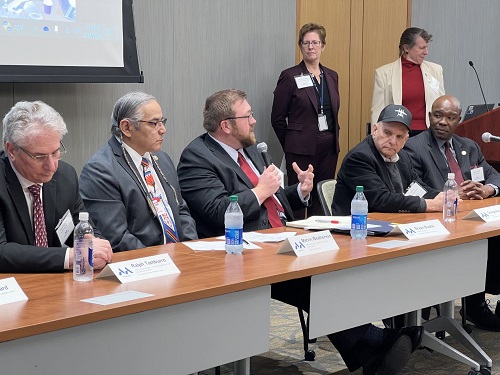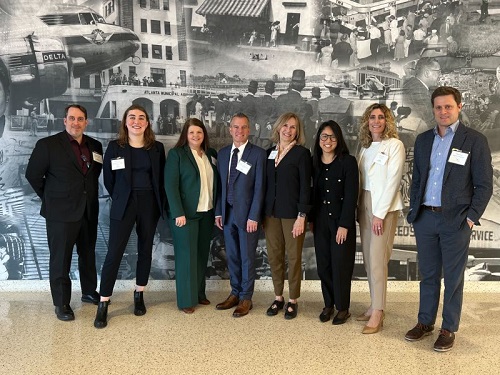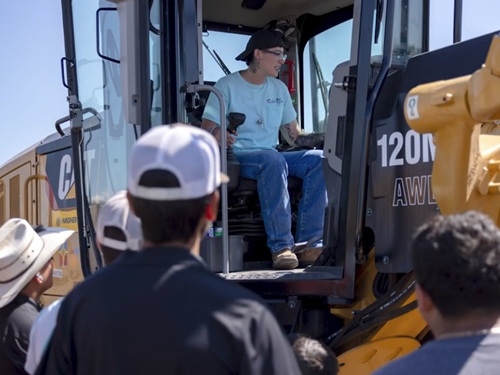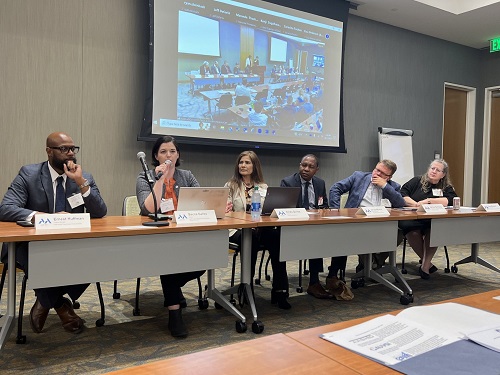State members and staff from the American Association of State Highway and Transportation Officials attended the U.S. Department of Transportation’s Advanced Air Mobility (AAM) Interagency Working Group meeting February 21-23 in Ft. Worth, TX, to offer insights into AAM planning and implementation efforts at the state and local level.
[Above photo by the National Association of State Aviation Officials]
The meeting represented an effort to emphasize community engagement by bringing together federal, state, and local government officials with industry stakeholders to provide input to help develop USDOT’s National AAM Strategy.
[Editor’s note: The Federal Aviation Administration released an implementation plan in July 2023 detailing the steps it and other aviation sector stakeholders must take to safely enable AAM operations in the near term. That “Innovate28” plan includes various components and the sequence in which they will occur for operations to be at scale at one or more sites by 2028.]

Leaders from three state departments of transportation participated in the “State and Local Planning Roundtable: State, Local, and Tribal Governments’ Perspectives” session held during the USDOT’s meeting.
Those leaders were Becca Gallas, director of aviation for the North Carolina Department of Transportation; Bryan Budds, deputy administrator for the Office of Aeronautics within the Michigan Department of Transportation and leader of AASHTO’s Uncrewed Aerial Systems and Advanced Air Mobility Inter-committee Working Group; and Ann Richart, director of the Aviation Division within the Washington State Department of Transportation.
Michigan DOT’s Budds emphasized the significance of adopting a “whole-of-state approach” to AAM planning and integration during the USDOT’s meeting; ensuring efforts are comprehensive and not isolated. He highlighted Michigan DOT’s commitment to this approach, underscoring the importance of multimodal integration to enhance the existing transportation network.
NCDOT’s Gallas and WSDOT’s Richart discussed the role of AAM in augmenting state capabilities and addressing equity concerns, respectively. Gallas spoke on the necessity of AAM’s integration into North Carolina’s multimodal transportation system, pointing out specific benefits to transit services and the ferry system and the crucial role of Metropolitan Planning Organizations (MPOs) in this process. Concurrently, Richart focused on ensuring AAM serves underserved communities, advocating for its use in enhancing small community air service.

Meanwhile, Shayne Gill and Barley Fields – AASHTO’s program director and associate program director for multimodal transportation, respectively – participated in the “State and Local Planning Roundtable: Association Perspectives” session held during the three-day workshop to examine the needs of state, local, and tribal governments when it comes to AAM operations.
At that session, Gill provided an overview of the AASHTO UAS and AAM Inter-committee Working Group, which is sponsored by AASHTO’s Council on Aviation; a working group that aims to facilitate engagement among states, and with key partners, on the emerging aviation technologies associated with UAS or Uncrewed Aerial Systems – commonly called drones – and AAM strategies.
[Editor’s note: In a comment letter filed in August 2023 with USDOT, AASHTO provided advice regarding short- and long-term efforts to help establish the AAM sector. AASHTO noted in its letter that state DOTs played a “vital role” in the development and deployment of new aviation technologies related to AAM – particularly where drones are concerned, using them to fulfill crucial agency functions such as bridge inspections and traffic incident response.]
Gill also discussed the importance of developing a long-term funding strategy for AAM, as planning for and developing this mode will increase the workload on state DOTs and other state agencies.
Fields then touched on the importance of defining the roles of federal and state agencies, as well as local governments, in planning for and integrating AAM into existing transportation systems – that includes, among other things, the importance of equity and community engagement when planning for and integrating AAM systems into the existing transportation system.
 Nation
Nation
Kansas DOT Profiled in State DOT 2-Minute Update
October 24, 2025 Nation
Nation

